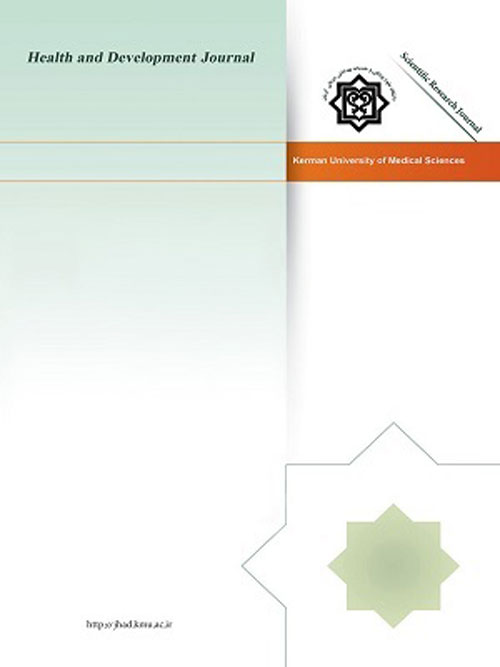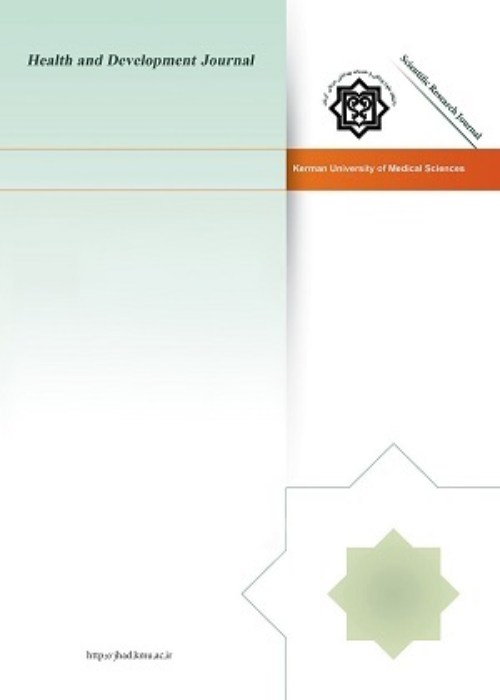فهرست مطالب

Health and Development Journal
Volume:10 Issue: 3, Summer 2021
- تاریخ انتشار: 1400/11/17
- تعداد عناوین: 8
-
-
Pages 147-154BackgroundThis study aimed to examine the effectiveness of habit reversal training (HRT) on anxiety and trichotillomania (TTM) symptomsMethodsThis experimental study was conducted using a pre-test-post-test design with a control group. The participants were 24 persons who were selected using convenience sampling from among female patients with trichotillomania (TTM) visiting medical clinics in Mashhad. The selected patients were randomly divided into intervention (n = 12) and control (n = 12) groups. The participants in the intervention group attended 8 habit reversal training (HRT) sessions, while the participants in the control group did not receive any intervention. All participants completed the items in the Massachusetts General Hospital (MGH) Hair pulling Scale and the State-Trait Anxiety Inventory (STAI) before and after the intervention. The collected data were analyzed using descriptive statistics (mean and standard deviation) and inferential statistics including analysis of variance (ANOVA) and chi-square test in SPSS software (version 21).ResultsThe results showed that after the HRT intervention, there was a significant difference between the intervention and control groups in terms of anxiety and trichotillomania (TTM) (P<0.001). The mean scores of anxiety and trichotillomania (TTM) for the participants in the intervention group were significantly lower than those of the control group and compared to the pretest, indicating that HRT intervention had a positive effect on reducing anxiety and trichotillomania (TTM).ConclusionHabit reversal treatment has a positive effect on reducing anxiety and trichotillomania (TTM) symptoms in patients with TTM.Keywords: Habit Reversal Training (HRT), Anxiety, Trichotillomania (TTM)
-
Pages 155-166BackgroundIncreased waste production is one of the main consequences of current urbanization and also the most important factor affecting the environment. Sanitary landfilling is the main waste disposal method in many countries, including Iran. The use of satellite and GIS data for municipal waste landfilling site selection is one of the new and fast landfilling site selection methods.MethodsThe data in this study were collected from relevant organizations and institutions and analyzed and standardized using ArcGIS10.3 software. Afterward, the criteria were weighted using expert opinions and the analytic hierarchy process (AHP) and a binary comparison matrix was formed in Expert Choice software to overlap the layers. Finally, the selected alternatives were ranked using the TOPSIS method.ResultsAfter ranking the selected alternatives using the TOPSIS method, the best site was selected in the south east of the specified region. The results indicated that the current landfill is located in a suitable place, but it cannot meet solid waste landfilling needs for at least the next 15 years.ConclusionGiven the problems of the current landfill in Qeydar (the capital of Khodabandeh County, Zanjan Province, Iran) and the growing population of this city, selecting a new landfill in the city is essential.Keywords: Solid waste landfilling site selection, Analytic hierarchy process (AHP), TOPSIS, Qeydar, Iran
-
Pages 167-173BackgroundCompliance with international standards makes it possible to upgrade hospitals in the field of health tourism. This study evaluated the readiness of hospitals in Ahvaz to attract health tourists using the Joint Commission International (JCI) accreditation standards.MethodsThis descriptive-analytical cross-sectional study was conducted in 2019 in 21 hospitals in Ahvaz. The participants were selected using the census sampling method. The data were collected using a questionnaire that assessed 8 main components of patient-centered standards. The face validity of the instrument was assessed and confirmed by subject-matter experts and its reliability was estimated using Cronbach’s alpha with a value of 0.87. The collected data were analyzed using descriptive statistics including mean, standard deviation, and percentage, and also inferential statistics including Mann-Whitney U tests, with SPSS 22 software.ResultsThe highest and lowest scores were related to the anesthesia and surgical care standard (83.47%) and the patient safety standard (70.71%), respectively. The mean score of these standards in non-teaching hospitals (80.15%) was higher than that of teaching hospitals (77.71%), but this difference was not significant (P = 0.205).ConclusionMedical centers can play a greater role in the health market by investing more in high-scoring standards and introducing them as their unique capabilities. In addition, low-scoring standards can be enhanced, if needed, by developing comprehensive staff training programs and modifying some processes.Keywords: Evaluation of hospitals, Ahvaz, Health tourism, Patient-centered standards, Joint International Commission
-
Pages 174-179BackgroundDental caries can lead to loss of tooth tissue, microbial infiltration to the pulp, pain and eventually tooth loss. WHO has set DMFT (Decayed, Missing, and Filled Teeth) index for measuring oral health. The aim of this research was studying the relation between drinking water fluoride concentration and DMFT index in the elementary schools of Sarayan County.MethodsThis study was conducted on 420 students in the cities of Saryan, Ayask, and Seh Qaleh in Sarayan County, South Khorasan Province, Iran. Data of DMFT were collected through observation and completion of a questionnaire. Fluoride concentration in well water samples was measured by SPADNS spectrophotometric method.ResultsThe average of fluoride concentration in 9 wells of drinking water samples was 0.34 mg/L. The amount of DMFT in 12-year old students was (2.21±0.1) which was higher than that 7-year olds (0.24±0.02). The average value of DMFT index was 1.34±0.08 and 1.29±0.06 for male and female students, respectively. No dental fluorosis was detected among studied students. Analysis showed a significant reverse relation between fluoride concentration and DMFT index (P-Value=0.02).ConclusionFluoride concentration in the water of Sarayan County was less than the minimum acceptable level of 0.5 mg/L. Although, DMFT values of less than 1 are acceptable by WHO, the measured values at Sarayan were higher than 1. Therefore, it is necessary to plan for oral and dental care and pay more attention to the regulations of fluoride in drinking water.Keywords: DMFT index, Drinking Water, Fluorides, Dental Caries
-
Pages 180-186BackgroundLight-curing dental restorative materials are currently used extensively. The effective use of these materials increases their properties and prevents damage to the tooth nerve. This study investigated general dentists’ knowledge about the function, safety, and infection control of light-curing units (LCUs) in Kerman in 2017.MethodsThis descriptive cross-sectional study was performed on 170 general dentists. The data were collected using a researcher-made questionnaire that assessed the dentists' demographic information and measured their knowledge of LCUs (7 items) and safety and infection control (2 items). The collected data were analyzed using analysis of variance (ANOVA) and t-test (P = 0.05) with SPSS 20 software.ResultsThe respondents’ mean age and dental service history were 35.77±9.25 and 9.97±8.08 years, respectively. The lifetime of the LCUs in 105 cases (61.8%) was more than 5 years. Moreover, 123 dentists (72.4%) did not have radiometers. It was also shown that 61.8% of the dentists were not aware of the light intensity of their light-curing units, but 68.8% of them were well aware of it. Most of the respondents used protective eyewear during dental services. The most common way to control unit infection was to use cellophane. The respondents’ mean knowledge score was 6.00±1.42 out of 7. The knowledge score had a statistically significant relation with having a radiometer, the number of daily composite restorations, and the lifetime of the unit.ConclusionGiven the technological advancements in dentistry, increasing dentists’ knowledge of using LCUs is essential to increase the life and quality of restorations.Keywords: Light curing unit, Knowledge, safety, dentists, Resin Composite, Infection Control
-
Pages 187-195BackgroundFoodborne and waterborne diseases are currently considered significant causes of death and related outbreaks throughout the world. Accordingly, this study investigated foodborne and waterborne disease outbreaks in Kerman Province.MethodsThe foodborne and waterborne disease outbreaks data in this descriptive-analytical study were collected from 2015 to 2019 in 9 cities that were registered in the Health Department of Kerman University of Medical Sciences. The outbreaks were examined and compared in terms of time (year, season, and month), county, etiological factors, type of food, and the place of the outbreak.ResultsA total of 160 waterborne and foodborne disease outbreaks occurred in 9 cities in Kerman province from 2015 to 2019, which led to 3111 diseases, 824 hospitalizations, and 3 deaths. Most outbreaks were reported in Kerman in the spring and were mainly caused by food containing meat. Moreover, the most important known factor was E. coli. Residential houses were also the most common site of the reported outbreaks.ConclusionGiven the high incidence of outbreaks in Kerman province, further education is necessary to improve the food health system and food safety.Keywords: Outbreak, Foodborne, waterborne diseases, Epidemiology, Kerman, Iran
-
Pages 196-205BackgroundOne of the main complications of wisdom tooth surgery is postoperative pain. Thus, various methods have been used to reduce postoperative dental pain. This study aimed to compare the effectiveness of the methanolic extract of green tea and chlorhexidine gel on pain after impacted wisdom tooth extraction.MethodsThe participants in this double-blind clinical trial study were 72 patients aged 18 to 40 years who had impacted wisdom teeth in the mandible requiring surgery. To reduce postoperative dental pain, 5% green tea extract and 0.2% chlorhexidine gel were used for one week after surgery. The collected data were analyzed using mean, standard deviation, frequency, and repeated measures ANOVA at a confidence level of 0.95.ResultsThe intensity of postoperative pain was at the highest level in both green tea and chlorhexidine gel groups on the first day and the pain intensity gradually decreased until the seventh day. The pain score reported by the patients using green tea was slightly lower than the pain score for the patients using chlorhexidine gel. However, there was no statistically significant intergroup difference in terms of the mean pain score (P = 0.21). There was a statistically significant difference between the groups that used green tea and chlorhexidine in terms of the number of analgesics used after surgery (P = 0.04). The mean number of analgesics used by the participants in the chlorhexidine group was higher.ConclusionGreen tea extract can be recommended as an effective compound in reducing the severity of pain after impacted wisdom tooth extraction.Keywords: Impacted tooth, Green tea, Chlorhexidine, Pain, Surgery
-
Pages 206-214BackgroundInadequate ergonomics can affect factors such as productivity and job involvement that play an important role in the sustainable development of organizations. To this end, the present study investigated the effect of workplace ergonomics and body composition on productivity and job involvement of employees in Kermanshah Oil Refinery.MethodsThe participants in this descriptive cross-sectional study were 160 persons who were selected using convenience sampling from refinery employees. The data were collected using the In-Body: Body Composition Analyzer, the Rapid Office Strain Assessment (ROSA), Rapid Upper Limb Assessment (RULA), Employee Productivity Scale (Achieve), and Job Involvement Scale. The data were analyzed using simple and multivariate linear regression analysis with SPSS 25 software at the significance level of 0.05 (P = 0.05).ResultsThe findings of the present study showed that the decreased level of workplace ergonomics has a negative and significant effect on productivity (p = 0.0001) and job involvement (p = 0.0001) of employees in Kermanshah Oil Refinery. Furthermore, employees’ body mass index (BMI) had a negative and significant effect on productivity (p = 0.031) and the waist-to-hip ratio (WHR) had a negative and significant impact on employees' job involvement (p = 0.039).ConclusionInadequate workplace ergonomics, high body mass index, and a high waist-to-hip ratio (WHR) can negatively affect the productivity and job involvement of oil refinery employees. Therefore, in addition to evaluating workplace ergonomics, managers are suggested to adopt strategies to provide proper ergonomics and promote employees’ health by holding training courses on healthy nutrition.Keywords: Ergonomics, Body Composition, Productivity, Job involvement, Musculoskeletal disorders


